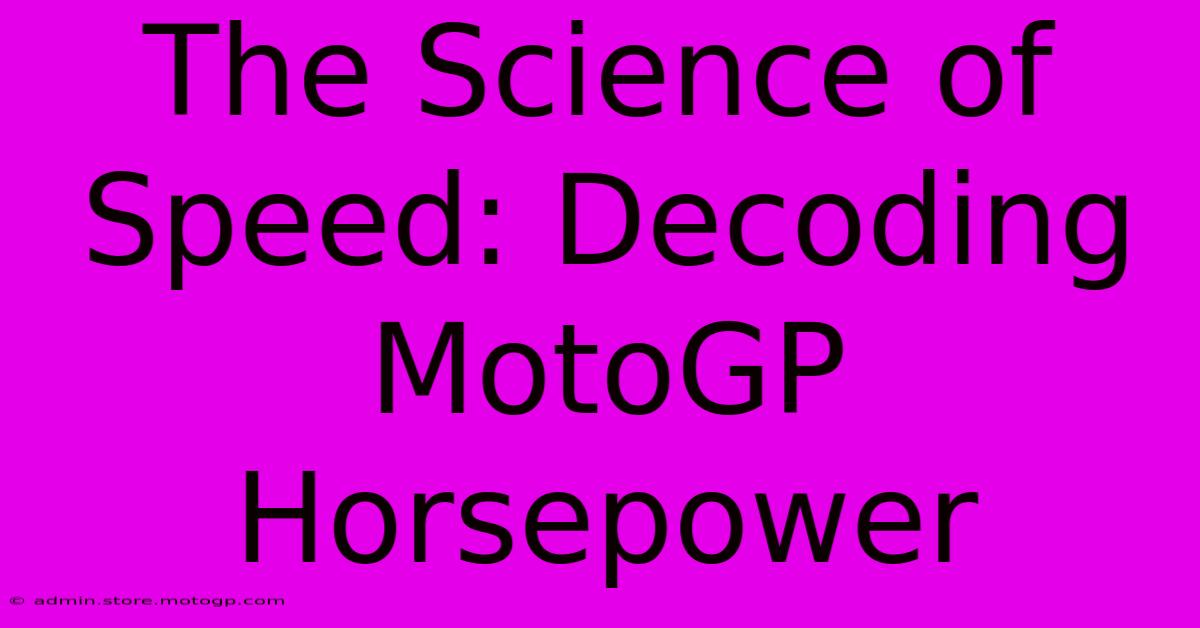The Science Of Speed: Decoding MotoGP Horsepower

Table of Contents
The Science of Speed: Decoding MotoGP Horsepower
MotoGP. The name itself evokes images of screaming engines, breathtaking speeds, and riders pushing the limits of human endurance. But behind the spectacle lies a fascinating world of engineering, where horsepower is king. This article delves into the science behind the staggering power output of MotoGP bikes, exploring the key components and innovative technologies that propel these machines to incredible speeds.
Understanding the MotoGP Powerhouse
MotoGP bikes are not your average motorcycles. These finely-tuned machines represent the pinnacle of two-wheeled motorsport technology, boasting horsepower figures that would make supercars blush. We're talking about power outputs exceeding 260 bhp – a figure achieved through a complex interplay of engine design, materials science, and aerodynamic efficiency.
The Heart of the Beast: The Engine
The engine is, without a doubt, the most crucial element. MotoGP regulations mandate a four-stroke, 1000cc engine, but within these constraints, manufacturers push the boundaries of innovation. Let's explore some key features:
-
High-Revving Power Plants: MotoGP engines are designed to operate at incredibly high RPMs, often exceeding 16,000 rpm. This high-revving nature allows for maximizing power output within the given displacement.
-
Sophisticated Valve Train: Advanced pneumatic valve systems ensure precise valve timing and actuation, vital for efficient combustion and maximizing power throughout the rev range.
-
Lightweight Materials: From titanium connecting rods to magnesium engine casings, the use of lightweight materials is paramount. Every gram saved contributes to improved handling and acceleration.
-
Cutting-Edge Electronics: Sophisticated engine management systems, including sophisticated fuel injection and ignition mapping, precisely control fuel delivery and ignition timing, optimizing performance across various track conditions and rider inputs.
Beyond the Engine: Aerodynamics and Chassis
While the engine provides the brute force, aerodynamics and chassis design play a critical role in translating that power into speed.
Aerodynamic Advantage:
Modern MotoGP bikes are masterpieces of aerodynamic engineering. Winglets, fairings, and other aerodynamic devices manage airflow, generating downforce that keeps the bike planted to the track at high speeds, enhancing stability and cornering performance. The pursuit of aerodynamic efficiency is a constant arms race amongst manufacturers, with each increment of downforce translating to faster lap times.
Chassis Dynamics:
The chassis, including the swingarm and suspension, needs to be incredibly stiff and responsive to handle the immense power and g-forces experienced during a race. Materials like carbon fiber are frequently used due to their exceptional strength-to-weight ratio.
The Rider Factor: Human-Machine Synergy
It's crucial to remember that the horsepower figure is only part of the equation. The rider's skill and ability to exploit the bike's potential are paramount. A highly skilled rider can extract maximum performance from the machine, pushing it to its absolute limits.
The Future of MotoGP Horsepower
The pursuit of ever-greater horsepower in MotoGP is an ongoing process. Manufacturers constantly refine existing technologies and explore new avenues of innovation. While regulations impose limits, the ingenuity of engineers ensures that the horsepower wars will continue, pushing the boundaries of what's possible on two wheels.
Conclusion:
The science of speed in MotoGP is a captivating blend of engineering prowess, aerodynamic finesse, and human skill. Understanding the intricate interplay of engine power, chassis dynamics, and rider expertise unveils the true magic behind the breathtaking speeds and thrilling races that define this pinnacle of motorcycle racing. The constant drive for more power and performance ensures that MotoGP will continue to enthrall audiences for years to come.

Thank you for visiting our website wich cover about The Science Of Speed: Decoding MotoGP Horsepower. We hope the information provided has been useful to you. Feel free to contact us if you have any questions or need further assistance. See you next time and dont miss to bookmark.
Featured Posts
-
Cota Apparel Dress To Impress
Feb 19, 2025
-
The Perfect Gift For Moto Gp Fans
Feb 19, 2025
-
Moto Gp Images Experience The Excitement Of Moto Gp
Feb 19, 2025
-
Unleash Your Inner Champion Moto Gp Motorcycle
Feb 19, 2025
-
Cota Parking Parking Assistance And Support
Feb 19, 2025
